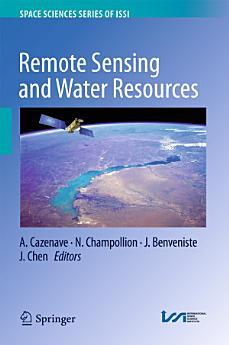Remote Sensing and Water Resources
A. Cazenave · N. Champollion · J. Benveniste · J. Chen
مايو 2016 · Space Sciences Series of ISSI الكتاب 55 · Springer
كتاب إلكتروني
337
صفحة
reportلم يتم التحقّق من التقييمات والمراجعات. مزيد من المعلومات
معلومات عن هذا الكتاب الإلكتروني
This book is a collection of overview articles showing how space-based observations, combined with hydrological modeling, have considerably improved our knowledge of the continental water cycle and its sensitivity to climate change. Two main issues are highlighted: (1) the use in combination of space observations for monitoring water storage changes in river basins worldwide, and (2) the use of space data in hydrological modeling either through data assimilation or as external constraints. The water resources aspect is also addressed, as well as the impacts of direct anthropogenic forcing on land hydrology (e.g. ground water depletion, dam building on rivers, crop irrigation, changes in land use and agricultural practices, etc.). Remote sensing observations offer important new information on this important topic as well, which is highly useful for achieving water management objectives.Over the past 15 years, remote sensing techniques have increasingly demonstrated theircapability to monitor components of the water balance of large river basins on time scales ranging from months to decades: satellite altimetry routinely monitors water level changes in large rivers, lakes and floodplains. When combined with satellite imagery, this technique can also measure surface water volume variations. Passive and active microwave sensors offer important information on soil moisture (e.g. the SMOS mission) as well as wetlands and snowpack. The GRACE space gravity mission offers, for the first time, the possibility of directly measuring spatio-temporal variations in the total vertically integrated terrestrial water storage. When combined with other space observations (e.g. from satellite altimetry and SMOS) or model estimates of surface waters and soil moisture, space gravity data can effectively measure groundwater storage variations. New satellite missions, planned for the coming years, will complement the constellation of satellites monitoring waters on land. This is particularly the case for the SWOT mission, which is expected to revolutionize land surface hydrology. Previously published in Surveys in Geophysics, Volume 37, No. 2, 2016
تقييم هذا الكتاب الإلكتروني
أخبرنا ما هو رأيك.
معلومات القراءة
الهواتف الذكية والأجهزة اللوحية
ينبغي تثبيت تطبيق كتب Google Play لنظام التشغيل Android وiPad/iPhone. يعمل هذا التطبيق على إجراء مزامنة تلقائية مع حسابك ويتيح لك القراءة أثناء الاتصال بالإنترنت أو بلا اتصال بالإنترنت أينما كنت.
أجهزة الكمبيوتر المحمول وأجهزة الكمبيوتر
يمكنك الاستماع إلى الكتب المسموعة التي تم شراؤها على Google Play باستخدام متصفح الويب على جهاز الكمبيوتر.
أجهزة القراءة الإلكترونية والأجهزة الأخرى
للقراءة على أجهزة الحبر الإلكتروني، مثل أجهزة القارئ الإلكتروني Kobo، عليك تنزيل ملف ونقله إلى جهازك. يُرجى اتّباع التعليمات المفصّلة في مركز المساعدة لتتمكّن من نقل الملفات إلى أجهزة القارئ الإلكتروني المتوافقة.










